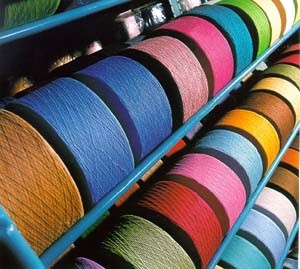At the Mission Valley Fabrics Division of PCCA
By John Johnson

Researching color trends up to 18 months in advance helps Mission Valley personnel design custom patterns. Photo by John Johnson
Mission Valley’s sales and marketing effort encompasses a critically important segment of the fashion industry; product development. This activity involves much more than guesswork. To be successful, new designs must be based on thorough research of fashion trends and consumer demands.
Jack Mathews, president of Mission Valley Fabrics Division of PCCA, and his staff travel regularly throughout the United States and Europe to gather information for the company to design new fabrics for its many customers. They also visit customers to determine their needs and to monitor retail sales trends. It is a tedious process that occurs months before the product reaches retail outlets.
“We shop Europe extensively to study and see first hand the fashion trends where they begin,” Mathews says. “We then translate these ideas to our customers’ needs and customize them to the American market.”
Mathews and his staff also research the color market and subscribe to color services that predict up to 18 months in advance the next color trend. Services provided by Cotton Incorporated also are utilized.
Following the research phase, Mission Valley personnel utilize a “computer-aided” design program to develop custom patterns. They then use hand looms to produce actual samples of fabric, and the sales staff presents these small samples to customers for initial approval more than a year before the product reaches store shelves. The Mission Valley plant in New Braunfels follows with production of larger samples of the patterns approved, and the customer will cut and sew these into garments. The entire process can take more than two months, during which numerous changes in the pattern can be requested by the customer.
The customers typically will place their orders in October for apparel products that will be sold for the following fall. Mission Valley’s fabrics will arrive at the customers’ cutting and sewing facilities between January and March, and the garments for the fall season will be delivered to retail stores by late July.
“About 90 percent of our apparel business is custom-made patterns, and our customers love that because their competitors will not have the same product to offer the consumer,” Mathews continues. To meet these commitments, Mission Valley employs more product development than sales personnel.
“Patterns for yarn-dyed woven fabrics have a short life span,” explains Mathews. “They are like the produce section of a grocery store, while denim is like the canned goods section.” Since Mission Valley presents two lines per year, spring and fall, to its customers, the entire process is a never-ending one.


